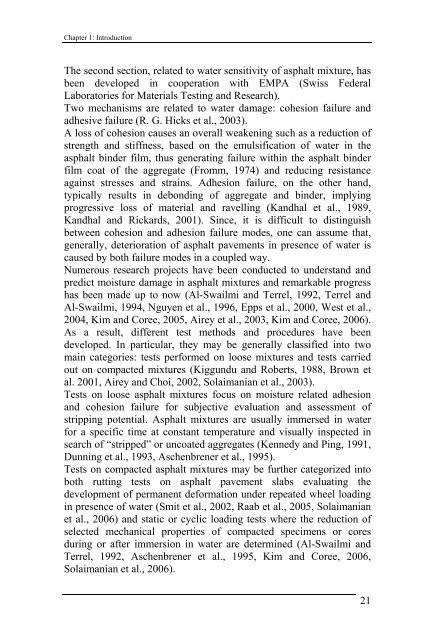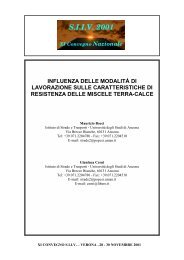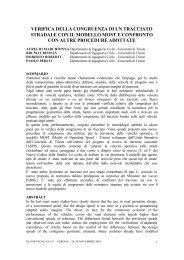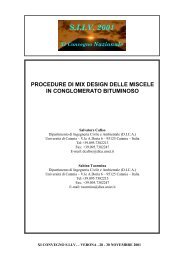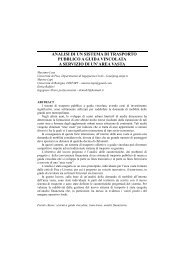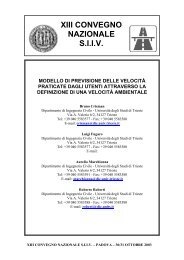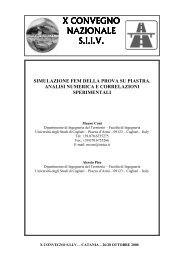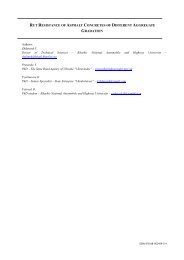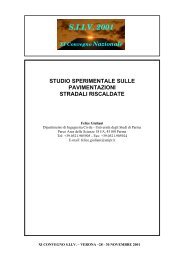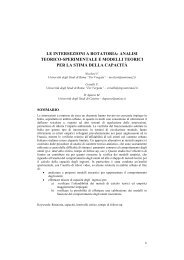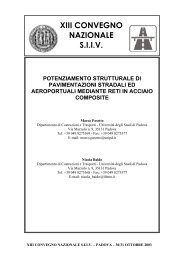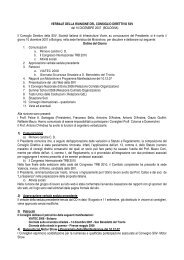DEF Grilli Andrea PhD Thesis 2007.pdf
DEF Grilli Andrea PhD Thesis 2007.pdf
DEF Grilli Andrea PhD Thesis 2007.pdf
Create successful ePaper yourself
Turn your PDF publications into a flip-book with our unique Google optimized e-Paper software.
Chapter 1: Introduction<br />
The second section, related to water sensitivity of asphalt mixture, has<br />
been developed in cooperation with EMPA (Swiss Federal<br />
Laboratories for Materials Testing and Research).<br />
Two mechanisms are related to water damage: cohesion failure and<br />
adhesive failure (R. G. Hicks et al., 2003).<br />
A loss of cohesion causes an overall weakening such as a reduction of<br />
strength and stiffness, based on the emulsification of water in the<br />
asphalt binder film, thus generating failure within the asphalt binder<br />
film coat of the aggregate (Fromm, 1974) and reducing resistance<br />
against stresses and strains. Adhesion failure, on the other hand,<br />
typically results in debonding of aggregate and binder, implying<br />
progressive loss of material and ravelling (Kandhal et al., 1989,<br />
Kandhal and Rickards, 2001). Since, it is difficult to distinguish<br />
between cohesion and adhesion failure modes, one can assume that,<br />
generally, deterioration of asphalt pavements in presence of water is<br />
caused by both failure modes in a coupled way.<br />
Numerous research projects have been conducted to understand and<br />
predict moisture damage in asphalt mixtures and remarkable progress<br />
has been made up to now (Al-Swailmi and Terrel, 1992, Terrel and<br />
Al-Swailmi, 1994, Nguyen et al., 1996, Epps et al., 2000, West et al.,<br />
2004, Kim and Coree, 2005, Airey et al., 2003, Kim and Coree, 2006).<br />
As a result, different test methods and procedures have been<br />
developed. In particular, they may be generally classified into two<br />
main categories: tests performed on loose mixtures and tests carried<br />
out on compacted mixtures (Kiggundu and Roberts, 1988, Brown et<br />
al. 2001, Airey and Choi, 2002, Solaimanian et al., 2003).<br />
Tests on loose asphalt mixtures focus on moisture related adhesion<br />
and cohesion failure for subjective evaluation and assessment of<br />
stripping potential. Asphalt mixtures are usually immersed in water<br />
for a specific time at constant temperature and visually inspected in<br />
search of “stripped” or uncoated aggregates (Kennedy and Ping, 1991,<br />
Dunning et al., 1993, Aschenbrener et al., 1995).<br />
Tests on compacted asphalt mixtures may be further categorized into<br />
both rutting tests on asphalt pavement slabs evaluating the<br />
development of permanent deformation under repeated wheel loading<br />
in presence of water (Smit et al., 2002, Raab et al., 2005, Solaimanian<br />
et al., 2006) and static or cyclic loading tests where the reduction of<br />
selected mechanical properties of compacted specimens or cores<br />
during or after immersion in water are determined (Al-Swailmi and<br />
Terrel, 1992, Aschenbrener et al., 1995, Kim and Coree, 2006,<br />
Solaimanian et al., 2006).<br />
21


